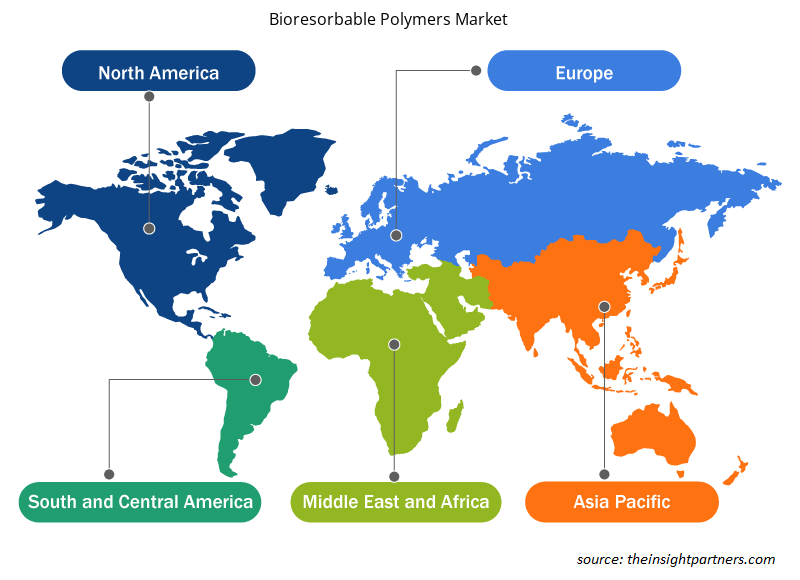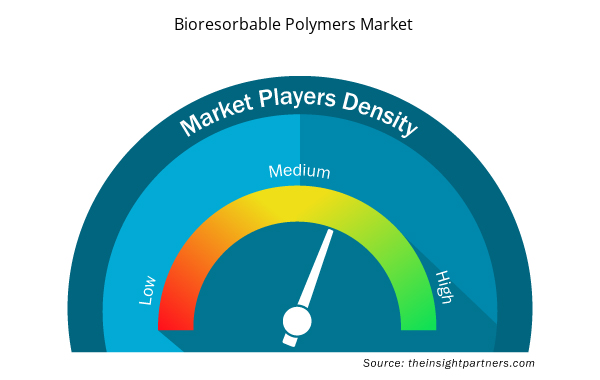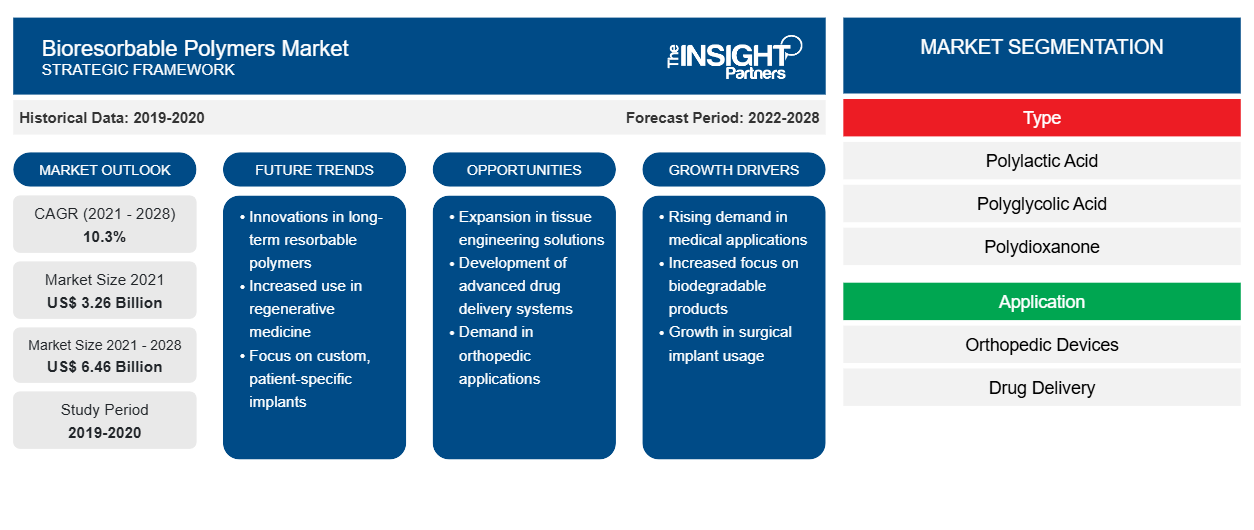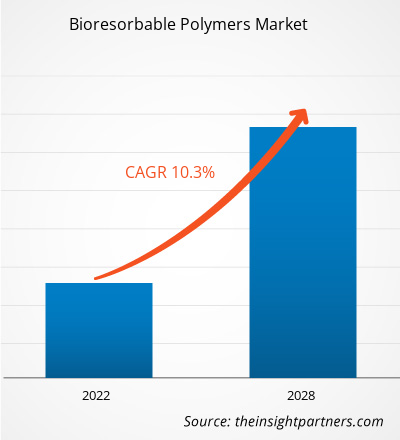생분해성 폴리머 시장은 2021년에 3,260.07백만 달러로 평가되었으며 2028년까지 6,463.07백만 달러에 도달할 것으로 예상됩니다. 2021년부터 2028년까지 연평균 성장률 10.3%로 성장할 것으로 예상됩니다.
생체흡수성 폴리머 기반 임플란트는 정형외과 수술에서 골절 고정에 널리 사용되고 있습니다. 간섭 나사, 플레이트, 핀, 봉합 앵커, 반월판 수리 임플란트, 단순 골절 고정 임플란트와 같은 정형외과 임플란트는 전방 십자인대 재건, 어깨 수술, 반월판 수리 및 골절 치료에 가장 일반적으로 사용되는 흡수성 임플란트입니다. 이러한 임플란트가 신체에 추가되면 원하는 작용을 수행하고 완료되면 이러한 임플란트는 스스로 신체에 흡수됩니다. 이러한 흡수성 폴리머 기반 임플란트에는 봉합사, 나사, 스텐트, 플레이트, 핀 등이 포함되며, 외상, 고관절, 무릎, 척추, 관절 및 기타 부상과 같은 다양한 정형외과 하위 응용 분야에 사용됩니다. 이러한 임플란트는 이식 후 치유 및 지지 과정에서 자연스럽게 분해됩니다. 따라서 도로 및 현장 사고의 증가는 정형외과 임플란트에 대한 수요를 촉진하고 결과적으로 생체흡수성 폴리머 시장 성장을 촉진하고 있습니다.
귀하의 요구 사항에 맞게 이 보고서를 사용자 정의하세요
이 보고서의 일부 또는 국가 수준 분석, Excel 데이터 팩을 포함하여 모든 보고서에 대한 사용자 정의를 무료로 받을 수 있으며 신생 기업 및 대학을 위한 훌륭한 혜택과 할인 혜택을 이용할 수 있습니다.
- 이 보고서의 주요 시장 동향을 알아보세요.이 무료 샘플에는 시장 동향부터 추정 및 예측까지 다양한 데이터 분석이 포함됩니다.
COVID-19 팬데믹이 생분해성 폴리머 시장에 미치는 영향
진행 중인 COVID-19 팬데믹은 전 세계적으로 다양한 산업의 성장에 상당한 혼란을 일으킬 것으로 예상됩니다. 그러나 특히 인도와 몇몇 다른 아시아 국가와 같은 국가에서 미래의 발병에 대한 불확실성은 여러 산업 부문의 지위를 바꾸었습니다. 다양한 아시아 태평양 국가의 정부는 산업 부문의 성장에 직접적인 영향을 미치는 전국적인 봉쇄를 발표하여 바이러스 확산을 제한하기 위한 가능한 조치를 취했습니다. 제조 단위의 폐쇄와 공급망의 혼란은 시장을 방해했습니다. 인도에서는 COVID 팬데믹 동안 도로 사고가 감소했습니다. 도로 교통 및 고속도로 장관에 따르면 도로 사고가 26.48% 감소했습니다. 도로 사고 감소로 인해 조직 공학 에 대한 사례가 감소하여 의료용 임플란트에 대한 수요가 감소하여 생분해성 폴리머 시장에 부정적인 영향을 미칩니다.
시장 통찰력
조직 공학을 위한 3D 스캐폴드 인쇄의 적용 증가
조직 공학을 위한 3D 스캐폴드 인쇄를 사용하여 장기와 같은 구조를 만드는 생체 흡수성 폴리머의 적용이 증가함에 따라 의료 산업에서 상당한 추진력을 얻고 있습니다. 생체 흡수성 폴리머는 뛰어난 세포 접착 특성을 가지고 있어 뼈, 힘줄, 연골, 치아 및 척추 재생과 같은 조직 공학 응용 분야에 적합합니다. 이러한 폴리머는 전기 방사 및 폴리머 인쇄와 같은 다양한 기술을 사용하여 스캐폴드로 제작되어 조직 개발을 용이하게 하는 미세 구조와 나노 소재를 만듭니다. 3D 스캐폴드 인쇄는 효율적이고 원활한 조직 공학을 위한 제어 가능한 기능을 갖춘 매우 복잡한 디자인을 생성할 수 있습니다. 3D 스캐폴드 인쇄를 위한 생체 흡수성 폴리머의 적용은 예측 기간 동안 조직 재생 치료 및 이 시장의 미래 트렌드가 될 것으로 예상됩니다.
유형 통찰력
유형에 따라 글로벌 생분해성 폴리머 시장은 폴리락트산(PLA), 폴리글리콜산(PGA), 폴리디옥사논, 폴리카프로락톤(PCL), 기타로 세분화됩니다. 폴리글리콜산(PGA) 세그먼트는 2020년 시장에서 가장 큰 매출 점유율을 기록하며 생분해성 폴리머 시장을 이끌었습니다.
애플리케이션 인사이트
응용 프로그램을 기준으로 글로벌 생분해성 폴리머 시장은 정형외과 기기, 약물 전달 및 기타로 세분화됩니다. 정형외과 기기 부문은 2020년 생분해성 폴리머 시장을 주도했습니다. Bezwada Biomedical, LLC; Evonik Industries AG; Foster Corporation; Ashland; Musashino Chemical Laboratory, Ltd.; Huizhou Foryou Medical Devices Co., Ltd.; Polysciences, Inc.; BMG; Poly-Med Incorporated; Reva Medical, LLC.는 전 세계의 주요 생분해성 제조업체입니다. 이러한 업체는 부작용 없이 인체에 적합한 생분해성 소재를 개발하기 위해 제품 혁신에 적극적으로 집중하고 있습니다.bioresorbable polymers market is segmented into orthopedic devices, drug delivery, and others. The orthopedic devices segment led the bioresorbable polymers market in 2020.
Biomedical, LLC; Evonik Industries AG; Foster Corporation; Ashland; Musashino Chemical Laboratory, Ltd.; Huizhou Foryou Medical Devices Co., Ltd.; Polysciences, Inc.; BMG; Poly-Med Incorporated; And Reva Medical, LLC., are the key bioresorbable manufacturers across the world. These players are actively focusing on product innovation to develop more bioabsorbable materials that suit the human body without leaving any side effects.
생분해성 폴리머 시장 지역 통찰력
Insight Partners의 분석가들은 예측 기간 동안 바이오리소버블 폴리머 시장에 영향을 미치는 지역적 추세와 요인을 철저히 설명했습니다. 이 섹션에서는 북미, 유럽, 아시아 태평양, 중동 및 아프리카, 남미 및 중미의 바이오리소버블 폴리머 시장 세그먼트와 지리에 대해서도 설명합니다.

- 생분해성 폴리머 시장에 대한 지역별 특정 데이터 얻기
생분해성 폴리머 시장 보고서 범위
| 보고서 속성 | 세부 |
|---|---|
| 2021년 시장 규모 | 32억 6천만 달러 |
| 2028년까지 시장 규모 | 64억 6천만 달러 |
| 글로벌 CAGR (2021-2028) | 10.3% |
| 역사적 데이터 | 2019-2020 |
| 예측 기간 | 2022-2028 |
| 다루는 세그먼트 | 유형별로
|
| 포함된 지역 및 국가 | 북아메리카
|
| 시장 선도 기업 및 주요 회사 프로필 |
|
생분해성 폴리머 시장 참여자 밀도: 비즈니스 역학에 미치는 영향 이해
생분해성 폴리머 시장 시장은 소비자 선호도의 변화, 기술 발전, 제품의 이점에 대한 인식 증가와 같은 요인으로 인해 최종 사용자 수요가 증가함에 따라 빠르게 성장하고 있습니다. 수요가 증가함에 따라 기업은 제품을 확장하고, 소비자의 요구를 충족하기 위해 혁신하고, 새로운 트렌드를 활용하여 시장 성장을 더욱 촉진하고 있습니다.
시장 참여자 밀도는 특정 시장이나 산업 내에서 운영되는 회사나 기업의 분포를 말합니다. 주어진 시장 공간에 얼마나 많은 경쟁자(시장 참여자)가 존재하는지 그 규모나 전체 시장 가치에 비해 나타냅니다.
생분해성 폴리머 시장에서 활동하는 주요 기업은 다음과 같습니다.
- BMG 주식회사
- 에보닉 인더스트리 AG
- 포스터 코퍼레이션
- 애슐랜드 글로벌 홀딩스 주식회사
- 폴리메드 주식회사
면책 조항 : 위에 나열된 회사는 어떤 특별한 순서에 따라 순위가 매겨지지 않았습니다.

- 생분해성 폴리머 시장 주요 업체 개요를 알아보세요
스포트라이트 보고서
- 생분해성 폴리머 시장의 진보적인 산업 동향은 플레이어가 효과적인 장기 전략을 개발하는 데 도움이 됩니다.
- 선진국과 개발도상국 시장에서 채택한 사업 성장 전략
- 2019년부터 2028년까지의 생분해성 폴리머 시장의 정량적 분석
- 생분해성 폴리머에 대한 세계 수요 추산
- 산업에서 운영되는 구매자와 공급자의 효율성을 설명하기 위한 포터의 분석
- 경쟁 시장 시나리오를 이해하기 위한 최근 개발
- 생분해성 폴리머 시장 성장을 촉진하고 제한하는 요인과 더불어 시장 동향 및 전망
- 상업적 관심을 뒷받침하는 시장 전략을 강조하여 의사 결정 프로세스를 지원하고 시장 성장을 이끕니다.
- 다양한 노드에서의 생분해성 폴리머 시장 규모
- 시장의 자세한 개요 및 세분화, 생분해성 폴리머 산업 역학
- 유망한 성장 기회를 가진 다양한 지역의 생분해성 폴리머 시장 규모
생분해성 폴리머 시장 – 유형별
- 폴리락틱산(PLA)
- 폴리글리콜산(PGA)
- 폴리디옥사논, 폴리카프로락톤(PCL)
- 기타
생분해성 폴리머 시장 – 응용 분야별
- 정형외과 장치
- 약물 전달
- 기타
회사 프로필
- 베즈와다 바이오메디컬, LLC
- 에보닉 인더스트리 AG
- 포스터 코퍼레이션
- 애슐랜드
- 무사시노 화학 연구소 주식회사
- 후이저우 포유 의료기기 유한회사
- 폴리사이언스 주식회사
- 비엠지
- 폴리메드 주식회사
- 레바 메디컬, 유한회사
- 역사적 분석(2년), 기준 연도, CAGR을 포함한 예측(7년)
- PEST 및 SWOT 분석
- 시장 규모 가치/양 - 글로벌, 지역, 국가
- 산업 및 경쟁 환경
- Excel 데이터 세트


- Health Economics and Outcome Research (HEOR) Services Market
- Pharmacovigilance and Drug Safety Software Market
- Identity Verification Market
- Electronic Health Record Market
- Investor ESG Software Market
- Electronic Shelf Label Market
- Photo Printing Market
- Nuclear Waste Management System Market
- Semiconductor Metrology and Inspection Market
- Vertical Farming Crops Market

Report Coverage
Revenue forecast, Company Analysis, Industry landscape, Growth factors, and Trends

Segment Covered
This text is related
to segments covered.

Regional Scope
North America, Europe, Asia Pacific, Middle East & Africa, South & Central America

Country Scope
This text is related
to country scope.
자주 묻는 질문
Asia Pacific is estimated to register the fastest CAGR in the market over the forecast period. The presence of high-growth markets such as India, China, and Japan due to the rapid increase in the geriatric population; increase in the number of hospitals; the implementation of favorable government initiatives; rise in investments in the healthcare industry; surge in demand for cutting-edge surgery products; and the expansion of private-sector hospitals in the rural areas are driving the market in the region. The increase in the elderly population across the region has led to a higher prevalence of osteoarthritis and other conditions, resulting in injuries requiring orthopedic devices.
The polylactic Acid (PLA) segment registered the fastest CAGR in the global bioresorbable polymers market. PLA is extensively used to manufacture medical implant devices and parts such as screws, pins, rods, and plates due to its biodegradable properties. The advantage of using PLA-based small parts in medical devices enables it to naturally convert into lactic acid in the body at low concentrations and can be safely removed by the body’s excretory system. Also, PLA is widely used in tissue engineering for bone tissue replacement purposes which is one of the most recent utilities of this polymer in medical science.
Orthopedic devices segment has led the bioresorbable polymers market in 2020, in terms of revenue. The orthopedic devices segment of the bioresorbable polymers market accounts for one of the largest revenue shares of the market. The growth of the segment can be attributed to the increasing sub-application of trauma, hip, knee, spine and bone surgery globally. The growing instances of accidents, sports injury, and the ageing population globally is surging the need for various joint and bone surgeries. Bioresorbable polymers are extensively used to make sutures, screws, stents, pins, rods, and plates in implant devices. After adding these devices to the body, they perform the desired action, and once done, these implants get absorbed in the body by themselves. Further, these implants break down naturally after implantation, during the healing and supporting process.
The polyglycolic acid segment of the bioresorbable polymers market is expected to grow at a notable rate in the forecast years. Polyglycolic acid is commonly used in scaffolds for various tissue engineering applications such as bone, tendon, cartilage, tooth, and spinal regeneration. Also, polyglycolic acid is a well-known alternative for PLA in orthopedic applications.
The major players operating in the bioresorbable polymers market are Bezwada Biomedical, LLC; Evonik Industries AG; Foster Corporation; Ashland; Musashino Chemical Laboratory, Ltd.; Huizhou Foryou Medical Devices Co., Ltd.; Polysciences, Inc.; BMG; Poly-Med Incorporated; and Reva Medical, LLC.
In 2020, North America held the largest revenue share of the global bioresorbable polymers market. The US and Canada mainly lead the demand for bioresorbable polymers in North America. Factors such as the growing number of FDA approvals for medical devices and the increasing presence of well-developed healthcare systems are driving the bioresorbable polymer market in the region. Further, the increased presence of orthopedic impairment patients in the region has led to a rise in demand for bioresorbable polymers.
Trends and growth analysis reports related to Chemicals and Materials : READ MORE..
The List of Companies - Bioresorbable Polymers Market
- BMG Incorporated
- Evonik Industries AG
- Foster Corporation
- Ashland Global Holdings Inc.
- Poly-Med Incorporated
- REVA Medical, LLC
- Musashino Chemical Laboratory, Ltd
- Huizhou Foryou Medical Devices Co., Ltd.
- Polysciences Inc
- Bezwada Biomedical LLC
The Insight Partners performs research in 4 major stages: Data Collection & Secondary Research, Primary Research, Data Analysis and Data Triangulation & Final Review.
- Data Collection and Secondary Research:
As a market research and consulting firm operating from a decade, we have published and advised several client across the globe. First step for any study will start with an assessment of currently available data and insights from existing reports. Further, historical and current market information is collected from Investor Presentations, Annual Reports, SEC Filings, etc., and other information related to company’s performance and market positioning are gathered from Paid Databases (Factiva, Hoovers, and Reuters) and various other publications available in public domain.
Several associations trade associates, technical forums, institutes, societies and organization are accessed to gain technical as well as market related insights through their publications such as research papers, blogs and press releases related to the studies are referred to get cues about the market. Further, white papers, journals, magazines, and other news articles published in last 3 years are scrutinized and analyzed to understand the current market trends.
- Primary Research:
The primarily interview analysis comprise of data obtained from industry participants interview and answers to survey questions gathered by in-house primary team.
For primary research, interviews are conducted with industry experts/CEOs/Marketing Managers/VPs/Subject Matter Experts from both demand and supply side to get a 360-degree view of the market. The primary team conducts several interviews based on the complexity of the markets to understand the various market trends and dynamics which makes research more credible and precise.
A typical research interview fulfils the following functions:
- Provides first-hand information on the market size, market trends, growth trends, competitive landscape, and outlook
- Validates and strengthens in-house secondary research findings
- Develops the analysis team’s expertise and market understanding
Primary research involves email interactions and telephone interviews for each market, category, segment, and sub-segment across geographies. The participants who typically take part in such a process include, but are not limited to:
- Industry participants: VPs, business development managers, market intelligence managers and national sales managers
- Outside experts: Valuation experts, research analysts and key opinion leaders specializing in the electronics and semiconductor industry.
Below is the breakup of our primary respondents by company, designation, and region:

Once we receive the confirmation from primary research sources or primary respondents, we finalize the base year market estimation and forecast the data as per the macroeconomic and microeconomic factors assessed during data collection.
- Data Analysis:
Once data is validated through both secondary as well as primary respondents, we finalize the market estimations by hypothesis formulation and factor analysis at regional and country level.
- Macro-Economic Factor Analysis:
We analyse macroeconomic indicators such the gross domestic product (GDP), increase in the demand for goods and services across industries, technological advancement, regional economic growth, governmental policies, the influence of COVID-19, PEST analysis, and other aspects. This analysis aids in setting benchmarks for various nations/regions and approximating market splits. Additionally, the general trend of the aforementioned components aid in determining the market's development possibilities.
- Country Level Data:
Various factors that are especially aligned to the country are taken into account to determine the market size for a certain area and country, including the presence of vendors, such as headquarters and offices, the country's GDP, demand patterns, and industry growth. To comprehend the market dynamics for the nation, a number of growth variables, inhibitors, application areas, and current market trends are researched. The aforementioned elements aid in determining the country's overall market's growth potential.
- Company Profile:
The “Table of Contents” is formulated by listing and analyzing more than 25 - 30 companies operating in the market ecosystem across geographies. However, we profile only 10 companies as a standard practice in our syndicate reports. These 10 companies comprise leading, emerging, and regional players. Nonetheless, our analysis is not restricted to the 10 listed companies, we also analyze other companies present in the market to develop a holistic view and understand the prevailing trends. The “Company Profiles” section in the report covers key facts, business description, products & services, financial information, SWOT analysis, and key developments. The financial information presented is extracted from the annual reports and official documents of the publicly listed companies. Upon collecting the information for the sections of respective companies, we verify them via various primary sources and then compile the data in respective company profiles. The company level information helps us in deriving the base number as well as in forecasting the market size.
- Developing Base Number:
Aggregation of sales statistics (2020-2022) and macro-economic factor, and other secondary and primary research insights are utilized to arrive at base number and related market shares for 2022. The data gaps are identified in this step and relevant market data is analyzed, collected from paid primary interviews or databases. On finalizing the base year market size, forecasts are developed on the basis of macro-economic, industry and market growth factors and company level analysis.
- Data Triangulation and Final Review:
The market findings and base year market size calculations are validated from supply as well as demand side. Demand side validations are based on macro-economic factor analysis and benchmarks for respective regions and countries. In case of supply side validations, revenues of major companies are estimated (in case not available) based on industry benchmark, approximate number of employees, product portfolio, and primary interviews revenues are gathered. Further revenue from target product/service segment is assessed to avoid overshooting of market statistics. In case of heavy deviations between supply and demand side values, all thes steps are repeated to achieve synchronization.
We follow an iterative model, wherein we share our research findings with Subject Matter Experts (SME’s) and Key Opinion Leaders (KOLs) until consensus view of the market is not formulated – this model negates any drastic deviation in the opinions of experts. Only validated and universally acceptable research findings are quoted in our reports.
We have important check points that we use to validate our research findings – which we call – data triangulation, where we validate the information, we generate from secondary sources with primary interviews and then we re-validate with our internal data bases and Subject matter experts. This comprehensive model enables us to deliver high quality, reliable data in shortest possible time.


 이 보고서에 대한 무료 샘플을 받으세요
이 보고서에 대한 무료 샘플을 받으세요